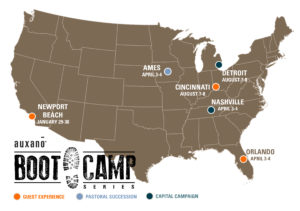Ever wonder why some people are influential, and others, well, aren’t?
Take getting others to buy into your ideas, for example. Some people seem always to be able to win the day with their ideas. Others, not so much.
I get asked all the time by leaders how to get their team members to take their ideas (and their leadership) more seriously.
What’s fascinating to me is that the conversation almost always begins from the angle of how to pitch ideas. It’s as though most of us have convinced ourselves that we just need a better argument, point or insight and then our ideas will catch on.
Sometimes that’s the case, but more often than not it’s deeper than that.
It’s easy to think leaders buy (or reject) our ideas. But I’m not sure what’s what really at play most of the time.
At a deeper level, it’s often a question of whether leaders buy you.
As harsh as it sounds, here’s the truth: if a leader doesn’t buy you, they’ll rarely buy your idea.
Leadership, as John Maxwell says, is influence. So the question about whether your ideas or viewpoint catches on quickly becomes a discussion about influence.
Your influence as a leader is never static. It’s either advancing or declining.
If you’re struggling to get your ideas adopted, you’ve likely got an influence issue as much as you have a communication problem.
If you have a strong influence at work, leaders will usually race to embrace or adopt your input. Conversely, if you’re not respected in the workplace, your ideas will likely get ignored no matter how logical or persuasive your ideas seem to you.
So how do you gain influence in the workplace? Here are 6 non-negotiable traits of leaders who have influence.
1. Be Sensational At What You Do
Not surprisingly, there’s a direct connection between competence and influence.
Leaders instinctively develop a habit of listening to their highest performing team members, even if they might initially disagree with their approach on issues.
When I see to leaders who never seem to be able to get their ideas adopted, I often wonder if it’s because their teammates don’t respect them.
If you want more influence at work, be sensational at what you do.
Your ideas are always attached to you. If people respect and admire you, they’ll tend to respect and admire your initiatives.
2. Grow Your Character
Being great at what you do is one thing.
But we’ve all met competent people who we don’t like spending time with.
Character impacts your influence as much as competency does.
And long term, it even matters more. Ultimately your character, not your competency, determines your capacity.
Why?
Because character is still the ultimate lid on leadership. Every day, highly competent leaders lose their jobs, their careers and their families because their character imploded.
Your competency will take you only as far as your character can sustain you. So work hard on your character. It’s the last cap on your leadership.
3. Cultivate Humility
The only person who likes a know-it-all is the know-it-all himself.
Paradoxically, if you want to cultivate greater influence, make your leadership less about you and more about others and the cause.
Prideful leaders are incredibly reluctant to share the spotlight. After all, you’ve worked so hard and so long, why share this moment with anyone? So if you’re a proud leader, you want the stage as often as it’s available. You want to chair everything and are reluctant to let anyone truly lead or get credit.
But humble leaders willingly push others into the spotlight.
They share credit. They share the stage. And they don’t have to lead everything.
In fact, they intentionally develop others leaders and even replace themselves in many key roles because the mission is more important than they are.
A humble leader rejoices in the success of others. A proud leaderresents the success of others.
If you want to overcome envy and insecurity, do what proud people fear doing: push others into the spotlight. It will break the stranglehold of envy in your life.
4. Do What You Said You Were Going To Do When You Said You Were Going To Do It
Honestly, if you want more influence starting tomorrow, just do what you said you were going to do when you said you were going to do it.
So few people do this.
Missed deadlines and excuses are the staples of the vast majority of people, including people in leadership positions.
Do you have any idea how many bosses/employers wake up every day to a string of phrases like:
- I’m sorry
- I didn’t get it done
- Sorry, I had a bunch of things come up
- Oh, I didn’t think it was that important
- I’m so slammed right now
- I just forgot
If you simply do what you said you’re going to do when you said you were going to do it, you’re ahead of 98% of the population of planet earth.
Furthermore, people will gain confidence in you.
And confidence, of course, is the basis of trust. If they know they can trust you, they’re far more likely to trust your ideas.
5. Initiate
A surprising number of people sit around waiting to be told what to do next.
The best leaders never do that. They see what needs to be done, and they do it.
If you’re not sure whether you have permission, ask.
An occasional “Hey is it all right if I reorganize this entire system?” is better than “I went home early because I couldn’t find anything to do.”
Leaders look for self-starters. Self-motivated people always have more influence than people who sit around waiting for their next assignment.
You likely have more permission than you think.
6. Finish
It’s great to start things. It’s another to finish them.
So many projects get started and then get abandoned. You and I can both point to hundreds of blogs and podcasts that started well and died a dozen posts or episodes in, because leaders had a lot of passion to begin but none to finish.
Ditto with projects at work.
So many great new initiatives fail to see daylight not because they were bad ideas, but because team members never finished what they started.
Shipping beats dreaming. Finishing trumps starting. Completing beats planning.
What Do You See?
These are 6 non-negotiable traits I see in leaders who are increasing their influence.
How about you?
> Read more from Carey.

Tags: Carey Nieuwhof, Influence, Leadership, Leadership Influence
|
What is MyVisionRoom? > | Back to Leadership >
































